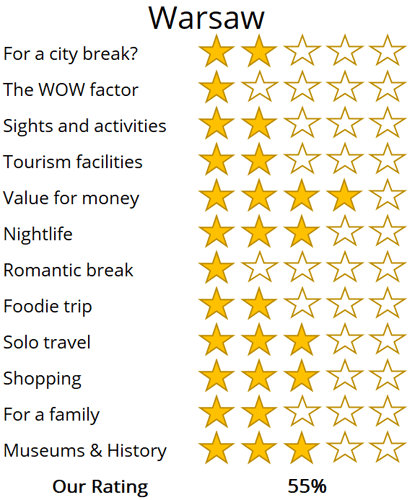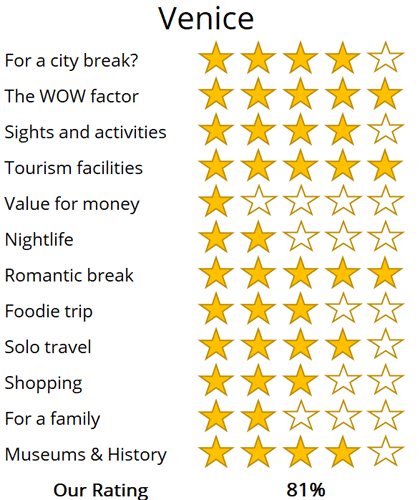WhereToGoForMyHoliday.com
The best destination comparison site!
WhereToGoForMyHoliday.com
The best destination comparison site!
Warsaw or Venice, which is better for your holiday in 2024?
Warsaw and Venice both offer unique and enticing experiences, but which one should you choose for your city break or holiday?
We understand your dilemma. There is an abundance of travel guides for both cities, but few actually comparing them, and advising you which is the better for your trip.
This article will provide our unbiased and independent views of Venice and Warsaw, hopefully making your choice that little easier.
The article is structured into several sections, each of which can be directly accessed through the following links:
• Introduction to the cities
• Scores and ratings
• Which one should I, friends, or family visit?
• When to visit and weather
• Who is the city suited for?
• The perfect 48hours (with map)
• Tourism details (where to stay? airport details?)
Introduction to Warsaw and Venice
Warsaw is a vibrant city that seamlessly blends the old with the new, offering a mix of historical sites and modern attractions.
This Polish capital is a city of contrasts. On one hand, you have futuristic shopping centres, and on the other, a Soviet-era skyscraper dominating the skyline. The Old Town, with its medieval appearance, is actually a meticulous reconstruction post-World War II.
It's this variety that makes Warsaw so intriguing. Whether you’re taking a romantic stroll through Łazienki Park, learning about the anti-Nazi uprisings, admiring Polish art in national galleries, or exploring the trendy Mokotow district, there’s always something new to discover.
Ah, Venice – a bucket-list city if there ever was one! Famed for its myriad canals, vast plazas and grand churches, this is one of Italy's most visited destinations.
Once the epicentre of its own trading empire that stretched right across the Mediterranean and even east to the Old Silk Road, it became rich on spices, precious metals, and cloth. These days, relics of that golden age remain. See them rise with the Orientalist spires of Saint Mark's Basilica. See them in the opulent interiors of the endless Doge's Palace.
But Venice is still a thriving town, not just a museum piece. Ferry boats weave through the Grand Canal and under arches where Canaletto and Monet once painted. Ice-cream parlours spill onto the narrow streets of Cannaregio. Pizzerias meet buzzy student bars scented with grappa around the Campo Santa Margherita. Yep, there's oodles of life left in this old seafaring dame!
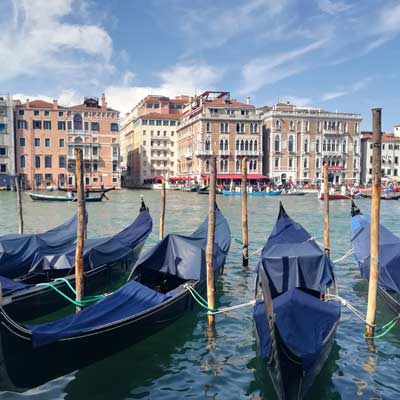
Grand Canal and gondolas waiting for the rush of tourists

The historic centre of Warsaw
Warsaw vs Venice: City Ratings
Summary
Where would I journey for a personal escape?
Venice
Where would I send my parents for a memorable visit?
Venice
Where's the ideal destination for my adventurous 19-year-old cousin?
Venice
Where should my food-obsessed friend indulge their culinary passions?
Venice
Note: The above comparisons are weather-independent and are based on travel during the most opportune times of the year. Details about the ideal travel seasons are elaborated upon later in this article.
In the sections that follow, you'll find a comprehensive comparison between these two fascinating cities. This includes recommendations on the duration of stay, the best times to visit, and tailored 48-hour itineraries for each city.
The final segment delves into practicalities for your travels, such as the best airport to fly into, the optimal districts for your accommodation, and insider tips, for when you come to explore the city.
We hope that you find all of this information useful, in planning your next exciting trip!
Destination details
How long to spend each city?
It's no secret that most people whiz in and out of Venice on big cruise ships, even if recent regulations are bringing a slow end to that.
Lots of weekenders also come on low-cost flights – Venice's Treviso Airport is a major hub for budget airlines like Ryanair and Easyjet. Those sorts of travellers can only ever really expect to scratch the surface of what's on offer.
The upshot? If you really want to explore this amazing city, you're going to need a little longer. If the budget allows, a week is perfect. That will be enough to see the mainstay sights, but also venture across to Murano and the Venice Lido, the party bars of Campo Santa Margherita, and the pathways of Giudecca.
Warsaw can be done quickly. Just a couple days is all you'll need to see the Old Town, the Palace of Culture and Science, the grand parks, and the main museums.
Of course, if you've got extra time to spare, Warsaw will always be able to fill it. Once you've checked off the main attractions, there are stacks of more local sights, eateries, and activities to get stuck into. They include café hopping down in hipster Mokotow, tasting ethnic foods in multicultural Praga, and even day outings to the Kampinos Forest or the post-industrial city of Łódź.

The Arsnal was the shipyard of Venice, which at its height could construct a boat in a single day

The Park Royal Baths Park (Łazienki Królewskie) is the largest park in Warsaw and a great location for a summers day
We're almost tempted to say forget Venice in the summer entirely. During the Italian high season between May and August, the whole place is packed to bursting with tourists. You can barely swing a slice of pizza on the Rialto Bridge or down on Piazza San Marco.
What's more, the horizon is tainted with the outlines of huge cruise ships.
Far better are the shoulder months of May and September. The crowds diminish considerably during those, but the weather still tends to be reasonable – think daytime temperatures regularly hitting the mid-20s.
The final weeks of February are also popular on account of the centuries-old tradition of the Venice Carnivale. Come then to join the revelry but be sure to bring along a flamboyant face mask (a must) and a good coat, because the winters can be cold.
It's probably a good idea to avoid the rest of the winter. Venice is one of the lowest-lying cities in the world, so flooding comes easy. In the last few years, there have been huge problems with water clogging up even the famous tourist hotspots around Piazza San Marco.
If you don't want to wrap yourself up in cotton wool and thermals every time you step outside, it might be best to avoid the winter months in Warsaw. From November to December, below-zero temperatures are normal in the Polish capital, along with icy rain, sleet and snow.
Most locals often say that spring and early autumn are the sweet spots. While summer's warm, it can often be humid, and there's no beach or ocean nearby to help you cool off. Months like April and May see milder days and cool nights, while September is prime time to wander the famous parks of Warsaw, as the trees begin to change colour and glow orange, ochre and yellow.
Warsaw captivates those who appreciate lively, bustling capital cities. While the Old Town is stunning, it's not the main attraction. Instead, expect to spend your time exploring vibrant and authentic neighborhoods, filled with a variety of dining options from fusion to fine dining. Discover craft beer on guided tours and enjoy artisan breakfasts in quirky cafes.
On the other hand, Warsaw offers a deeply immersive historical experience. The Warsaw Uprising Museum and the POLIN exhibitions provide insightful introductions to the challenges faced by the Polish people and Polish Jews during Nazi occupation. Don't miss the 800,000 exhibits at the renowned National Museum, and take time to explore grand parks, complete with Chinese gardens and monuments dedicated to Chopin.
Venice is a perfect break for those keen to check off another bucket-list city. Yes, it might be over touristed, but there's still something truly magical about the canals and the gondolas and the great churches here.
It's simply unlike anywhere else on the planet. All that adds an edge of romance to boot. So, consider this one if you're searching for a city-based honeymoon.
On the flip side, Venice isn't for the budget traveller or the outdoorsy person. Yes, you can hop on a bus to go north to the Dolomites, but they are still several hours away.
There are beaches, but they are nowhere near the best on the Italian east coast. And you can expect to pay over the odds for virtually everything, from hotels to ice creams to pizza.

The gothic Saint Florian's Cathedral in Warsaw
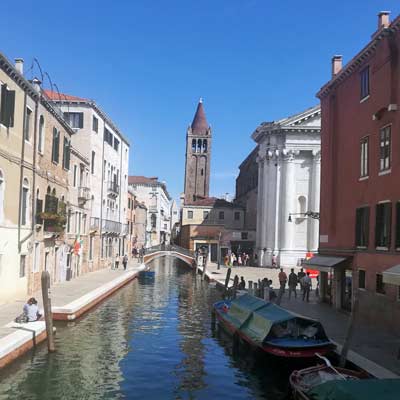
The pretty Ponte dei Sospiri and canals of Venice
48hours in Venice
Delve into the secrets and the uber-famous sights of Venice with this 48-hour itinerary. It will take you from the legendary walks of the Rialto Bridge all the way to the hidden glass workshops of Murano, revealing some of the most enthralling corners of the iconic City of Canals.
Day 1: Rise early and race to the Piazza San Marco. Beating the crowds to the vast plaza is a great way to see it in all its glory. As the sun rises, watch as the light caresses the red-brick Campanile (a 98-meter belfry dating from the 12th century) and the bulbous domes of St Marks Basilica.
If you've managed to arrive before the queues start to form, be sure to duck into the latter. It's free to enter and has intricate Byzantine apses and frescos. Right next door is the Doge's Palace. Again, if it's too late you can certainly expect a queue. If not, head behind the Gothic frontispiece to wander the old palace of the erstwhile leaders of the Venetian republic.
Then head north through the narrow alleys of the San Marco district. It's a beautiful maze of little side streets, occasionally punctuated by a watery canal. You're sure to find a cafeteria there for lunch, before you go straight for the Rialto Bridge, made famous by Shakespeare and painters. Cross it and hit the buzzing markets of Ruga dei Oresi, which abut the small Campo Bella Vienna, a top spot to sit with a cold beer and watch elegant Venetian gondolas drift in and out of the canals.
If you choose not to ride one, you can push on to see the San Giacomo di Rialto (probably the oldest church in the whole city!) and then the neighbourhood around Campo Santa Margherita. That's a nightlife mecca, where you can unwind with a prosecco or ten.
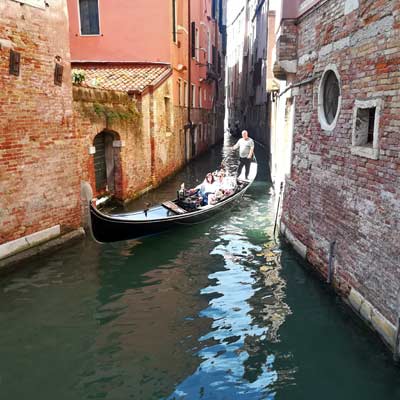
No trip to Venice is complete without a gondolas ride
Day 2: Your second 24 hours in Venice is all about hitting the different districts. We'd recommend starting on the northern side of the archipelago. That's home to characterful Cannaregio; the old Jewish Quarter. These days, it's got canal-side cafés next to the fascinating Muso Ebraico di Venezia, which tells the story of Venetian Jews over the centuries.
From there, move west to Santa Croce. Within, you'll glimpse the lived-in city. It's the only place where cars can travel on the archipelago and it has newer churches and loads of bakeries and shops. Hop the Grand Canal ferry (number 3) from there to Murano.
Pastel-painted workshops meet the water on that island, in an area that's been famed for centuries for its glass making. If you're interested, the Museum of Glass is a great place to start.
Alternatively, enjoy a lunch on the lagoon and then get back on the boat, travelling all the way through the Grand Canal to the Dorsoduro. The zone has beautiful broadside views of Piazza San Marco at sunset. It's also home to plenty of lovely osterias with northern Italian wines and delicacies to get stuck into.
Related articles: 48-hours in Venice

The vaporetti ferries are the best way to get a waterside view of Venice
48hours in Warsaw
This perfect first 48 hours offers a fun-filled and exciting introduction to life in the Polish capital. It's a cocktail of wartime history, art, and – of course – good old Slavic beer.
Day 1: Hit the Old Town of Warsaw as early as you can. That way, you'll avoid the crowds, and – on a sunny day – get to catch the gilded medieval-style frontispieces in some perfect photography light. You certainly won't want to miss a moment on grand Plac Zamkowy (Castle Square).
The Royal Castle that gives it the name is the star of the show, with its orange-tinged exteriors and Baroque domes. It, like the whole rest of the Old Town, is actually deceptively new. The entire district had to be rebuilt from ruins in the wake of WWII.
Wait for the folk from the Free Walking Tour under Zygmunt's Column. Their two-hour odyssey through this part of the capital really digs down into the unique mosaic of architecture. After that's done, you can hit Nowy Swiat and follow the route Polish monarchs once took in and out of the city. It's now a buzzing modern thoroughfare with dumpling taverns and beer halls (perfect for lunch).
Follow it all the way south and hop a few more blocks and you'll soon be in Łazienki Park. It's an icon of the metropolis. An evening stroll here could start with a vision of the huge Chopin statue and end with a sighting of the Classicist Temple of Diana. For dinner, where better than hipster Mokotow? The district has everything from Tex-Mex to stylish sushi bars.

The Warsaw Barbican (barbakan warszawski) dates from 1540, and was part of the fortifications that encircle the city
Day 2: A selfie stop outside of the iconic Palace of Culture and Science starts day two with a bout of Soviet architecture. A 237-metre spire of a building, it was a personal gift to Poland by one Joseph Stalin. From there, a few trams stops can whisk you over to the Warsaw Uprising Museum. The enthralling exhibits of that showcase the heroic efforts of Poland's underground resistance during the fight against the Nazis.
Afterwards, make straight for the riverside and the leafy Vistula Boulevards. They're a hubbub of life in the summer months. Dog walkers meet buskers and street entertainers right by the water. (An optional drop into the family-friendly Copernicus Science Centre is a great addition if the rain's a-pouring). For the evening, hip and elegant Praga awaits. That's arguably Warsaw's most stylish area, with Lebanese kitchens giving way to bohemian bars and cool coffee shops.

The striking Palace of Culture, standing at 237m is the tallest building in Poland
Public transport in Warsaw means trams and buses. The network of more than 260 combined lines can take you virtually anywhere you want to go.
What's more – it's cheap! Just 3,4 PLN can get you from A to B on any route, but there are also 24- and 72-hour tickets that won't break the bank. You can get them at machines located at the stops, or in any kiosk dotted around town.

Saint Alexander’s Church was constructed in honour of the Russian tsar Alexander I
Warsaw has two international airports. There's the larger Warsaw Frederic Chopin Airport, which can be reached by direct train from Warsaw's main station on line S2 or S3. The smaller Warsaw Modlin International Airport is a hub for European low-cost carriers. To go from terminal to city from there, you can ride the private Modlinbus, or catch the loop train that goes to both airports and then Warszawa Centralna.
A big Polish presence and a welcoming local vibe means there's rarely trouble for tourists in WarsawPickpockets, angry bouncers in clubs, and the classic European taxi scammers are the most common frustrations beyond that. .
When it comes to picking a hotel, it's typically best to be on the western side of the Vistula River. Some of the very best accommodation choices hide amid the cobbled lanes and squares of the Old Town. Others sit within walking distance, by Mirow or the Palace of Culture and Science. Being on the far side of the river means finding some cool aparthotels in local's favourite Praga.
Venice is largely safe and easy to travel. However, there are some things worth knowing before you go. First off, the overload of tourists has seen a huge spike in pickpockets over the years. So, always keep an eye on your valuables, especially in uber-popular spots like the Piazza San Marco and Erbaria.
Second, be wary that Venice's side streets are rarely empty. You'll always need to dodge a crowd and watch where you're walking. When it rains, flooding is common, so pack waterproofs and wellies if you're visiting in the winter months. Also, keep an eye out for pigeons. They're a nuisance on the piazzas and can even carry disease.
Navigating Venice isn't like navigating any other place in Europe. Taxis and buses simply don't exist – there are no real roads here, after all. Instead, you can make use of the ferries (known locally as vaporetti).
They run routes up and down the Grand Canal and out to other islands like Murano all throughout the day. They're actually a great way to see the main sights, with tickets for a full 24 hours costing as little as €20.

Rarely will you find a steet this quiet in Venice……
There are two airports serving Venice and its region. The largest and the closest to town is the international hub at Marco Polo Airport. That's got connections going all around the world. It's linked to the city by the ATVO bus (arrives at Piazzale Roma) and to the train station in Mestre.
If you're flying low-cost, it's more likely you'll arrive at Treviso Airport. That sits some 20 miles to the north, with buses that link to the archipelago in around 70 minutes for about €10 each way.
Choosing where to stay in Venice is very important. Fly-in, fly-out tourists will want to be in the vicinity of Piazza San Marco. The area is laced with expensive and classy hotels, but also has some more affordable options, all within walking distance of the top sights.
If to save some cash and get somewhere a little quieter, you could sleep closer to Dorsoduro or the Cannaregio, or even out in Murano. The cheapest places of all will be on the mainland, in Mestre.
Related articles: Where to stay in Venice?

oh we were stuck in the airport!

Copenhagen was a bit expensive...

All we did was drink beer in Brussels...

Muncih was crazy

And we got so burnt!

Remeber that night in Rome

oh we were stuck in the airport

So much fun kayaking

Berlin and that group from Austria!

There was such a view from that church

And we got so burnt!

Munich was eventful, wasn't it!

Such a view from that cathedral in Florence

Lisbon was such so much fun

Last summer was so much fun .... x

Remeber that night in Rome

Lisbon was such so much fun

Such a view from that cathedral in Florence

Munich was eventful, wasn't it!

And we got so burnt!

Remeber that night in Rome

All we did was drink beer in Brussels...

Berlin and that group from Austria!

Can't wait to go back to Dubrovnik

Remember that boat ride in Prague

Copenhagen was a bit expensive...
